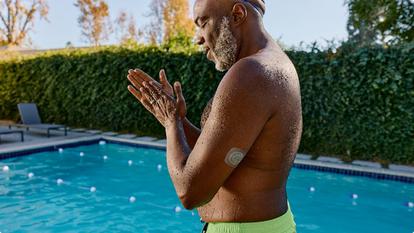Glucose basics
How heat can affect blood sugar levels (and what to do about it)
Published: Jul. 15, 2025
Updated: Aug. 20, 2025
2 min read

The content in this article should not be taken as medical advice. Please consult with your healthcare provider regarding your individual health needs.
When most people think about glucose management, they think about nutrition and activity. But seasonal changes (especially high heat) can also have a real impact on blood sugar levels. For those using a glucose biosensor like Stelo, summertime offers a unique opportunity to learn how heat, hydration, and outdoor activity affect your body. Understanding these patterns can help you make smarter decisions and stay in range more consistently.

How heat changes your body’s workload
When temperatures rise, your body has to work harder to stay cool. That means more sweating, increased blood flow to the skin (vasodilation), and, in many cases, more energy burned just trying to regulate your core temperature.
One common result is dehydration. Even mild dehydration can concentrate glucose in your bloodstream, potentially leading to higher glucose levels, especially if you’re not replenishing fluids and electrolytes.
How heat affects your blood sugar levels
High heat can drive glucose up or down depending on the situation. Blood sugar can rise due to dehydration, elevated stress hormones, or disrupted routines. On the other hand, glucose levels may gradually lower if you’re more physically active, which we often are in summer.

Summer situations to keep an eye on
Everyday summer scenarios can influence your glucose (sometimes in sneaky ways). Here are a few examples:
Outdoor workouts
These can lead to faster glucose drops, especially if you haven’t fueled beforehand or you’re sweating more than usual.
Travel
Long drives, flights, or sightseeing can raise blood sugar levels due to stress, dehydration, or changes in eating habits.
Beach and pool days
Spending hours soaking up the sun by the pool or relaxing on the beach can sometimes blur the signs of glucose level changes, which might even be mistaken for heat exhaustion.
Barbecues
From sweet sauces to refined carbs and sugary drinks, summer barbecues can lead to unexpected glucose spikes, especially if you’re grazing over a period of hours. Try to stick with grilled protein, add fiber-rich sides, and watch for sneaky sugars in sauces and drinks.

How to stay in range during hot weather
Here are a few proactive steps can help keep your glucose levels steady in the heat:
Stay hydrated
Drink plenty of water throughout the day, especially before and after being outdoors. Add a pinch of salt or sip electrolyte drinks (without added sugar) if you’re sweating a lot.
Snack smart for summer heat
If you’re active in the heat, fuel up with a balanced snack beforehand. Here are some easy options to consider before heading out in the heat (and when you’re on the go):
- Nut butter and crackers
- A piece of fruit with cheese
- Trail mix
- Hummus and veggie sticks
Eat for balance
Summer meals tend to be lighter, which can be great. Just remember to aim for a mix of protein, fiber, and healthy fat to help slow glucose spikes.
Stay cool, stay informed
Summer routines can be unpredictable. That’s where Stelo comes in. Tracking your glucose 24/7 enables you to see how your glucose responds to heat, hydration, and activity. Having a better sense of your habits and trends helps you know how to adjust what you eat or drink based on your personal patterns. And you’ll be able to spot changes early, before symptoms set in.
Glucose tracking isn’t just about food. It’s about understanding how your entire lifestyle affects your unique body. Now’s a great time to tune in to how you respond to the summer heat so you can enjoy the season while staying in range.

Curated & Reviewed by: Nahom Petros
PharmD, MBA
Dr. Nahom Petros, PharmD, MBA joined the Clinical Education team at Dexcom in 2024, where he develops content that aligns with Dexcom’s mission of advancing diabetes care and innovating medical technology.
